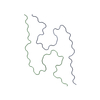+Search query
-Structure paper
| Title | Cryo-EM structures of amyloid-β filaments with the Arctic mutation (E22G) from human and mouse brains. |
|---|---|
| Journal, issue, pages | Acta Neuropathol, Vol. 145, Issue 3, Page 325-333, Year 2023 |
| Publish date | Jan 7, 2023 |
 Authors Authors | Yang Yang / Wenjuan Zhang / Alexey G Murzin / Manuel Schweighauser / Melissa Huang / Sofia Lövestam / Sew Y Peak-Chew / Takashi Saito / Takaomi C Saido / Jennifer Macdonald / Isabelle Lavenir / Bernardino Ghetti / Caroline Graff / Amit Kumar / Agneta Nordberg / Michel Goedert / Sjors H W Scheres /     |
| PubMed Abstract | The Arctic mutation, encoding E693G in the amyloid precursor protein (APP) gene [E22G in amyloid-β (Aβ)], causes dominantly inherited Alzheimer's disease. Here, we report the high-resolution cryo- ...The Arctic mutation, encoding E693G in the amyloid precursor protein (APP) gene [E22G in amyloid-β (Aβ)], causes dominantly inherited Alzheimer's disease. Here, we report the high-resolution cryo-EM structures of Aβ filaments from the frontal cortex of a previously described case (AβPParc1) with the Arctic mutation. Most filaments consist of two pairs of non-identical protofilaments that comprise residues V12-V40 (human Arctic fold A) and E11-G37 (human Arctic fold B). They have a substructure (residues F20-G37) in common with the folds of type I and type II Aβ42. When compared to the structures of wild-type Aβ42 filaments, there are subtle conformational changes in the human Arctic folds, because of the lack of a side chain at G22, which may strengthen hydrogen bonding between mutant Aβ molecules and promote filament formation. A minority of Aβ42 filaments of type II was also present, as were tau paired helical filaments. In addition, we report the cryo-EM structures of Aβ filaments with the Arctic mutation from mouse knock-in line App. Most filaments are made of two identical mutant protofilaments that extend from D1 to G37 (App murine Arctic fold). In a minority of filaments, two dimeric folds pack against each other in an anti-parallel fashion. The App murine Arctic fold differs from the human Arctic folds, but shares some substructure. |
 External links External links |  Acta Neuropathol / Acta Neuropathol /  PubMed:36611124 / PubMed:36611124 /  PubMed Central PubMed Central |
| Methods | EM (helical sym.) |
| Resolution | 1.99 - 3.5 Å |
| Structure data | EMDB-16022, PDB-8bfz: EMDB-16023, PDB-8bg0: EMDB-16027, PDB-8bg9: |
| Chemicals |  ChemComp-HOH: |
| Source |
|
 Keywords Keywords | PROTEIN FIBRIL / Amyloid / filaments / amyloid-beta / Arctic mutation / APP / E22G / E693G / NL-G-F / mouse brains |
 Movie
Movie Controller
Controller Structure viewers
Structure viewers About Yorodumi Papers
About Yorodumi Papers









 homo sapiens (human)
homo sapiens (human)
